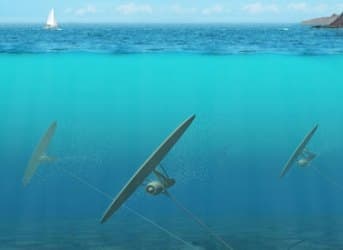One of childhood’s happiest memories is flying kites. Now, an American academic is developing a novel idea – underwater kites equipped with turbines to generate electricity from ocean currents.
Ramping up the potential ridicule factor, a number of media outlets reporting on the technology note the proposed underwater kite’s eerie resemblance to the starship “Enterprise.”
But the National Science Foundation is not among the skeptics, having awarded a three-year, $300,000 grant to Worcester Polytechnic Institute for a new research program directed by David J. Olinger, PhD, associate professor of mechanical engineering to research ways to harness ocean currents and tidal flows using the novel technology.
Professor Olinger is convinced of the research’s potential, noting, "Unseen under the waves, winding along coastlines and streaming through underwater channels, there are countless ocean currents and tidal flows that bristle with kinetic energy. And just as wind turbines can convert moving air into electricity, there is the potential to transform these virtually untapped liquid 'breezes' into vast amounts of power. For example, it has been estimated that the potential power from the Florida Current, which flows from the Gulf of Mexico into the Atlantic Ocean, is 20 gigawatts—equivalent to about 10 nuclear power plants."
The tethered kites will be anchored to the seabed and fly a figure 8 pattern, something that Professor Olinger believes will produce significant advantages over stationary marine turbines, used on a limited scale in Europe, Asia, and North America to generate electricity from tides, commenting, "For one, the generators can be smaller, since with the figure-eight motion the kite will move three- to five times faster than the current, greatly amplifying the power output— which could be as much as 64 times greater than the output of a comparably sized stationary turbine. And, since the kites will be attached to floating platforms, rather than located on the sea floor, they will be substantially less expensive to install and easier to retrieve for maintenance.
One thing that is not in doubt is the kinetic energy of deep ocean currents. The Gulf Stream, first noted by Ponce de Leon and later studied and named by Benjamin Franklin, is a strong ocean current transporting water at a rate of 30 million cubic meters per second through the Florida Straits before turning northwards along the U.S. eastern seaboard. By the time the Gulf Stream passes south of Newfoundland, it the rate increases to 150 million cubic meters per second.
Extrapolating from Professor Olinger’s Florida Current calculations, this fivefold increase could theoretically produce 100 gigawatts, roughly equivalent to the output of 50 NPPs. The volume of the Gulf Stream dwarfs all rivers that empty into the Atlantic combined, which barely total 0.6 million cubic meters per second.
And Professor Olinger is no “fly by night” (pardon the pun) academic, having authored over fifty technical papers in engineering journals and conference proceedings.
The physical dynamics of the concept are well understood. Dr. Olinger said, “Instead of moving air, you have moving water and the kites have rigid wings. But the same physical principles apply.”
Professor Olinger’s team will begin by developing computational models to virtually test potential designs for subsea kites and explore techniques for tethering them to floating platforms similar to those used for oil and gas rigs. The final stage of the team’s research will build scale models of the kites for testing them at WPI’s water tank and at the hydraulic facilities at Alden Research Laboratory, Inc., founded by WPI in 1894, the oldest continuously operating hydraulic laboratory in the United States.
And, across the “Pond,” Sweden’s Saab subsidiary Minesto is also experimenting with similar technology. Its “Deep Green” converts energy from tidal stream flows into electricity using a subsea kite equipped with a turbine. The Deep Green ‘underwater kite’ marine power plant is already producing electricity in the waters off Northern Ireland and as for the technology’s potential, Minesto says, when the system is fully deployed in British tidal waters, “The system will generate an additional 18 terawatt hours (TWh) of power, roughly enough to provide 3.8 million households in the UK with green, reliable electricity each year, or the entire population of Surrey, Essex, and Kent combined.” Expect to see large-scale investment on these programs – soon…
By. John C.K. Daly of Oilprice.com



















If we want long term, lean, clean, green, RELIABLE energy, let us start deploying Liquid Fluoride Thorium Reactors.